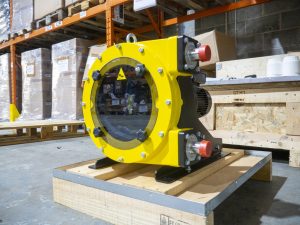Cooking on a mass scale requires no small amount of precise engineering. A corn tortilla manufacturer was having steam control issues controlling temperature with the saturated steam used to heat the cooking kettles for the corn. The manufacturer came to Proportion-Air seeking a solution.
A visit to the plant revealed the company was using an I-to-P transducer, steam valve, RTD (resistance temperature sensor), and PID (proportional-integral-derivative) loop to control the temperature. The issue arose out of a regular failure of the I-to-P transducer.
While the failing I-to-P is what caught the customer’s attention, the complicated, expensive and inefficient control valve setup isn’t necessary to control the temperature of saturated steam. The temperature of saturated steam is directly related to its pressure. It’s a predictable and repeatable relationship.
The I-to-P was ultimately replaced with a Proportion Air QB1X, a product better able to withstand standard industrial air. I-to-Ps require instrument air, which is filtered to less than 5 microns and is moisture- and lube-free. A Burling Valve BD4 dome-loaded pressure reducing regulator took the place of the steam valve. This assembly was installed and subsequently performed extremely well, saving the customer time and money.
Benefits of Using the QB and Saturated Steam Regulator
There are many benefits to using a Proportion-Air saturated steam regulator system, especially when compared to the operation of traditional steam valves.
Achieving and maintaining the correct temperature quickly is a priority for many applications. Since the manufacturer did not require the ultra-high accuracy of the QB2X, which can achieve ±0.5% of full-scale accuracy with external pressure feedback, a QB1X was used. QB1X on a steam regulator has +/4% accuracy. Regardless of whether the QB1X or QB2X was selected, the control loop did not have to work as hard, because the saturated steam regulator could compensate for changes in flow while maintaining pressure on its own, without the assistance of sophisticated electronic controls. An on-board analog comparator through the electronic pilot means no PID tuning is required.
Contrast that with a steam valve, which has no direct connection to pressure downstream and cannot connect for downstream changes without a PID loop closing the loop around pressure (or temperature). The temperature is also less accurate, because the link between flow and temperature is not directly related. The PID will constantly overshoot and undershoot setpoint, trying to compensate for pressure/temperature changes downstream. With a saturated steam regulator assembly, temperature is achieved more quickly and remains accurate and stable.
Maintenance is also an issue in any facility. The Burling Valve regulator offers easy in-line repairs and maintenance. The reduces the downtime necessary when a regulator needs work.
Source of Article



